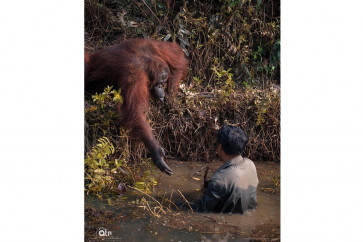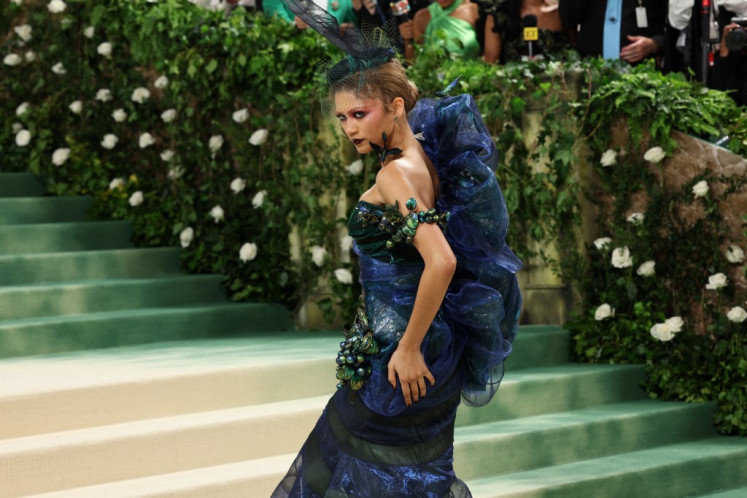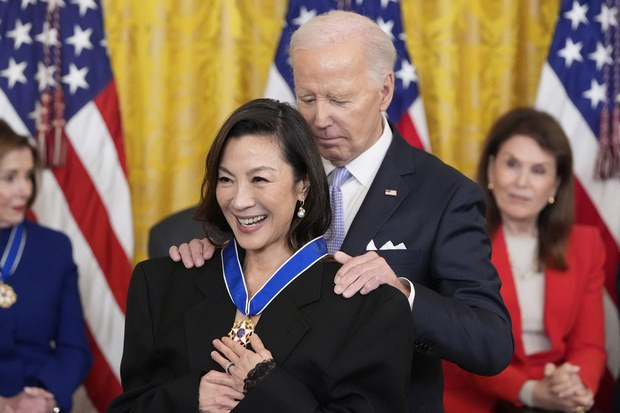Illustrators seek equal footing with authors in Indonesian publishing scene
Book illustrators long for a holistic publishing environment that rewards artists for their time and skills.
Change Size
 Sekar Bestari, a book illustrator, works on a design on her tablet. Creating a book illustration is often undervalued in the publishing industry, even though the creative process involves a complicated labor of research. (Courtesy of/Sekar Bestari)
Sekar Bestari, a book illustrator, works on a design on her tablet. Creating a book illustration is often undervalued in the publishing industry, even though the creative process involves a complicated labor of research. (Courtesy of/Sekar Bestari)
Sometimes, people do judge a book by its cover.
Every story may have its own charm, but a work of fiction can usually shine brighter on a bookshelf with the help of an enchanting illustration gracing its cover.
Unfortunately, with the way the publishing industry is set up, authors tend to steal most of the limelight, while book illustrators are quietly relegated to the sidelines.
Sekar Bestari, a 28-year-old illustrator based in Ngaglik, Sleman regency, Yogyakarta, said she discovered from poring through readers’ testimonials that enough people buy a book for its attention-grabbing cover.
Even so, there are only a few publishers in the country that are willing to allocate enough funds to commission work from illustrators specializing in book covers.
“Most publishers will get their in-house designers to do them – they’ll do any work thrown at them. Unfortunately, this affects the [low] going rate for illustration commissions,” she told The Jakarta Post recently.
When she started working as an illustrator for independent publishers in 2017, Sekar said her rate could go anywhere between Rp 300,000 (US$21.39) and Rp 500,000 per cover.
“Nowadays, my average rate for mainstream publishers is Rp 1 million to Rp 2 million, although I charge differently for independent publishers,” she said.
Publishers usually own the rights to a book’s cover illustration, but the illustrators don’t receive any further royalties when books are reprinted, Sekar explained.
Read also: Indonesian 'X-Men Gold' comic writer inserts anti-Ahok references in comic book, ignites controversy
Paying it forward
Since starting her career, Sekar has created illustrations for over 80 book covers that include the translated works of Franz Kafka and Arthur Conan Doyle.
She got her first break through husband Tomi Wibisono, illustrating a promotional poster for a book he coedited with Soni Triantoro, which in turn opened the doors to indie publishers in Yogyakarta commissioning her work.
With her traditional style of using watercolors and acrylic paint in her drawings, Sekar said she had felt inferior about entering the book illustration scene, which is still dominated by male artists.
“My style is quite feminine, with soft lines and bright pastel colors, so at first I thought these mostly male publishers and authors would steer clear of me,” she said on Feb. 24.
Her worries, as it turned out, were largely unfounded, although female book illustrators still remain a rarity.
“All kinds of art scenes are still dominated by men,” she said.
To pay it forward, Sekar founded Katalika Project with fellow artist Bambang Nurdiansyah, aiming to bridge the gap between young artists and publishers.
“If the workload gets overwhelming or if the illustration requested is different to our style, we will connect publishers with other illustrators,” she said.
Creative processes
In Indonesia’s flourishing art and literature scenes, networking and personal relationships are pivotal for progressing one’s career, especially among freelancers.
Sometimes a gig may come from strangers on the internet who come across an artist’s work, but more often than not, the rewarding and well-paying jobs come from personal connections.
Read also: Artists, illustrators join forces to welcome ‘Gundala’ movie
For Silmi Sabila, 26, a part-time illustrator based in Tebet, South Jakarta, creating a book cover is a complex process that draws directly from discussions with the author.
Her proximity to Sabda “Dio” Armandio, a coworker who commissioned her in 2019 to make a cover illustration for his sophomore novel 24 Jam Bersama Gaspar (24 Hours With Gaspar), gave her the opportunity to have intense discussions about the direction of her work for the piece.
“I read the book first and discussed it with Dio. The story is pretty complex and contains many small details,” she told the Post in a recent interview.
In creating the cover illustration, she first drew a sketch manually on paper, using a brush pen for the inking, before coloring it digitally using software. It took her a month to transform her sketch into the finished product.
“Before making the sketch, I made a mood board and researched visual and color references to match the nuance that we wanted to present,” Silmi said of her creative process.
The project was a rewarding distraction from her main job at media company Tirto.id as content creator for social media and company reports. She makes time to create comic strips as a recreational outlet.
“It was my first time working on a book illustration and I’m pretty satisfied with how it came out. I am interested in working on more [book] covers, but I haven’t gotten any more orders,” she said on Feb. 23.
Holistic appreciation
For emerging illustrators, creating an outstanding portfolio is imperative in order to reach more potential clients, said Leopold Adi Surya, 31, a writer and a former book illustrator for Kepustakaan Populer Gramedia (KPG), one of Indonesia’s biggest publishers.
“You can create your portfolio while working for a publisher or if you’re still at school, you can create a book illustration as a part of an assignment or final project,” Leo told the Post on Feb. 23.
“Once you have a solid portfolio, post it on your social media or send it to a publisher. Start networking with people outside of designer circles. Show your work to authors; all writers want their books to have great covers,” he said.
Leo’s first gig as a book illustrator was for Sergius Seeks Bacchus, a collection of 33 poems written by his boyfriend Norman Erikson Pasaribu, which was published by Gramedia Pustaka Utama (GPU) in 2016.
Despite his intimate relationship with the writer, Leo said he still insisted on pitching to the publisher and sending his portfolio to the literary editor to get their approval.
Read also: Depiction of struggle of Indonesia’s gays in 'Sergius Mencari Bacchus'
Since then, he has been getting a constant stream of projects and was hired as a full-time illustrator by KPG.
He has also lost count of how many book illustrations he has done.
“I started to develop a portfolio of book illustrations when I joined KPG. I am grateful that KPG has a welcoming work environment and is very queer-friendly. I feel like my [being openly gay] is respected there,” he said.
Beyond his thoughts about the importance of a working environment that is inclusive of lesbian, gay, bisexual and transgender (LGBT) people, Leo longs for a publishing ecosystem that respects the illustrating process holistically.
For him, it is important to understand that a book illustration is not merely a “pretty thing to post” on social media that can be cooked up quickly and on the cheap.
“A book illustration is the result of a long process involving time, research and a working human,” he said.









